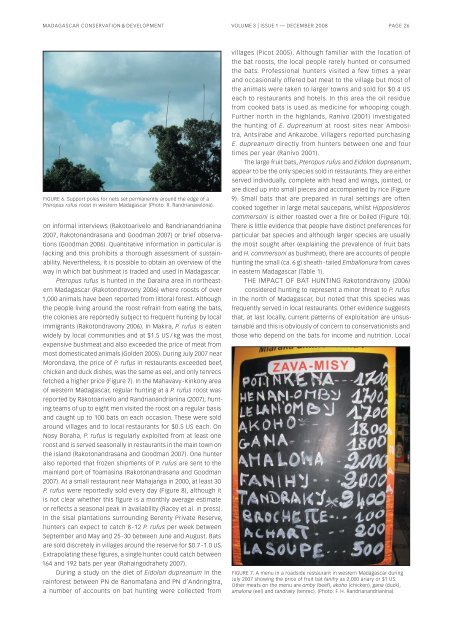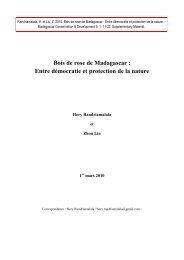Journal Madagascar Conservation - Madagascar Wildlife ...
Journal Madagascar Conservation - Madagascar Wildlife ...
Journal Madagascar Conservation - Madagascar Wildlife ...
Create successful ePaper yourself
Turn your PDF publications into a flip-book with our unique Google optimized e-Paper software.
MADAGASCAR CONSERVATION & DEVELOPMENT VOLUME 3 | ISSUE 1 — DECEMBER 2008 PAGE 26<br />
FIGURE 6. Support poles for nets set permanently around the edge of a<br />
Pteropus rufus roost in western <strong>Madagascar</strong> (Photo: R. Randrianavelona).<br />
on informal interviews (Rakotoarivelo and Randrianandrianina<br />
2007, Rakotonandrasana and Goodman 2007) or brief observa-<br />
tions (Goodman 2006). Quantitative information in particular is<br />
lacking and this prohibits a thorough assessment of sustain-<br />
ability. Nevertheless, it is possible to obtain an overview of the<br />
way in which bat bushmeat is traded and used in <strong>Madagascar</strong>.<br />
Pteropus rufus is hunted in the Daraina area in northeast-<br />
ern <strong>Madagascar</strong> (Rakotondravony 2006) where roosts of over<br />
1,000 animals have been reported from littoral forest. Although<br />
the people living around the roost refrain from eating the bats,<br />
the colonies are reportedly subject to frequent hunting by local<br />
immigrants (Rakotondravony 2006). In Makira, P. rufus is eaten<br />
widely by local communities and at $1.5 US / kg was the most<br />
expensive bushmeat and also exceeded the price of meat from<br />
most domesticated animals (Golden 2005). During July 2007 near<br />
Morondava, the price of P. rufus in restaurants exceeded beef,<br />
chicken and duck dishes, was the same as eel, and only tenrecs<br />
fetched a higher price (Figure 7). In the Mahavavy - Kinkony area<br />
of western <strong>Madagascar</strong>, regular hunting at a P. rufus roost was<br />
reported by Rakotoarivelo and Randrianandrianina (2007); hunting<br />
teams of up to eight men visited the roost on a regular basis<br />
and caught up to 100 bats on each occasion. These were sold<br />
around villages and to local restaurants for $0.5 US each. On<br />
Nosy Boraha, P. rufus is regularly exploited from at least one<br />
roost and is served seasonally in restaurants in the main town on<br />
the island (Rakotonandrasana and Goodman 2007). One hunter<br />
also reported that frozen shipments of P. rufus are sent to the<br />
mainland port of Toamasina (Rakotonandrasana and Goodman<br />
2007). At a small restaurant near Mahajanga in 2000, at least 30<br />
P. rufus were reportedly sold every day (Figure 8), although it<br />
is not clear whether this figure is a monthly average estimate<br />
or reflects a seasonal peak in availability (Racey et al. in press).<br />
In the sisal plantations surrounding Berenty Private Reserve,<br />
hunters can expect to catch 8 - 12 P. rufus per week between<br />
September and May and 25 - 30 between June and August. Bats<br />
are sold discretely in villages around the reserve for $0.7 - 1.0 US.<br />
Extrapolating these figures, a single hunter could catch between<br />
164 and 192 bats per year (Rahaingodrahety 2007).<br />
During a study on the diet of Eidolon dupreanum in the<br />
rainforest between PN de Ranomafana and PN d’Andringitra,<br />
a number of accounts on bat hunting were collected from<br />
villages (Picot 2005). Although familiar with the location of<br />
the bat roosts, the local people rarely hunted or consumed<br />
the bats. Professional hunters visited a few times a year<br />
and occasionally offered bat meat to the village but most of<br />
the animals were taken to larger towns and sold for $0.4 US<br />
each to restaurants and hotels. In this area the oil residue<br />
from cooked bats is used as medicine for whooping cough.<br />
Further north in the highlands, Ranivo (2001) investigated<br />
the hunting of E. dupreanum at roost sites near Ambositra,<br />
Antsirabe and Ankazobe. Villagers reported purchasing<br />
E. dupreanum directly from hunters between one and four<br />
times per year (Ranivo 2001).<br />
The large fruit bats, Pteropus rufus and Eidolon dupreanum,<br />
appear to be the only species sold in restaurants. They are either<br />
served individually, complete with head and wings, jointed, or<br />
are diced up into small pieces and accompanied by rice (Figure<br />
9). Small bats that are prepared in rural settings are often<br />
cooked together in large metal saucepans, whilst Hipposideros<br />
commersoni is either roasted over a fire or boiled (Figure 10).<br />
There is little evidence that people have distinct preferences for<br />
particular bat species and although larger species are usually<br />
the most sought after (explaining the prevalence of fruit bats<br />
and H. commersoni as bushmeat), there are accounts of people<br />
hunting the small (ca. 6 g) sheath - tailed Emballonura from caves<br />
in eastern <strong>Madagascar</strong> (Table 1).<br />
THE IMPACT OF BAT HUNTING Rakotondravony (2006)<br />
considered hunting to represent a minor threat to P. rufus<br />
in the north of <strong>Madagascar</strong>, but noted that this species was<br />
frequently served in local restaurants. Other evidence suggests<br />
that, at last locally, current patterns of exploitation are unsustainable<br />
and this is obviously of concern to conservationists and<br />
those who depend on the bats for income and nutrition. Local<br />
FIGURE 7. A menu in a roadside restaurant in western <strong>Madagascar</strong> during<br />
July 2007 showing the price of fruit bat fanihy as 2,000 ariary or $1 US.<br />
Other meats on the menu are omby (beef), akoho (chicken), gana (duck),<br />
amalona (eel) and tandraky (tenrec). (Photo: F. H. Randrianandrianina).



